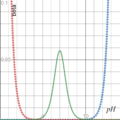Buffer solution facts for kids
A buffer solution is a special chemical mix. It helps keep the pH (or acidity) of a liquid steady. Think of it like a pH bodyguard!
It is a solution in water. It usually contains a weak acid (or base) and its salt. The pH of the solution changes very little. This happens even when a small amount of strong acid or base is added. Buffer solutions are used to keep pH almost constant. This is important in many chemical jobs. Many living things need a steady pH. For example, our blood is a buffer solution.
Contents
What are Buffer Solutions?
A buffer solution is a mix of chemicals. It helps a liquid resist changes in its pH. pH tells us how acidic or basic something is. A low pH means it's acidic. A high pH means it's basic. A pH of 7 is neutral.
Buffers are very important. They stop big changes in pH. This is useful in many places. For example, our bodies need a very stable pH. Our blood has natural buffers. These buffers keep our blood pH just right. If the pH changes too much, it can be dangerous.
How Buffers Work Their Magic
Buffer solutions are usually made from two things:
When you add a small amount of strong acid to a buffer, the buffer's basic part reacts with it. This removes the extra acid. When you add a small amount of strong base, the buffer's acidic part reacts with it. This removes the extra base. This way, the pH stays almost the same.
Types of Buffer Solutions
Buffer solutions can be divided into two main types:
Acidic Buffers
These buffers are made from a weak acid and a salt of that acid. The salt is usually formed with a strong base.
- Example: A mix of acetic acid (CH3COOH) and sodium acetate (CH3COONa). Acetic acid is a weak acid. Sodium acetate is its salt.
Basic Buffers
These buffers are made from a weak base and a salt of that base. The salt is usually formed with a strong acid.
- Example: A mix of ammonium hydroxide (NH4OH) and ammonium chloride (NH4Cl). Ammonium hydroxide is a weak base. Ammonium chloride is its salt.
How Buffers Handle pH Changes
Imagine you have a buffer solution.
- Adding Acid: If you add acid, you add more H+ ions. The buffer has a part that can grab these extra H+ ions. It turns them into something harmless. This stops the pH from dropping too much.
- Adding Base: If you add base, it removes H+ ions from the solution. The buffer has another part that can release more H+ ions. This replaces the ones that were removed. This stops the pH from rising too much.
This balancing act is how buffers keep the pH steady.
Buffer Capacity
Every buffer has a limit to how much acid or base it can handle. This limit is called its buffer capacity.
- Buffer capacity is how many moles of acid or base you can add to one liter of buffer solution before its pH changes by one unit. Once you add too much, the buffer "breaks," and the pH will change a lot.
Images for kids
See also
 In Spanish: Tampón químico para niños
In Spanish: Tampón químico para niños


